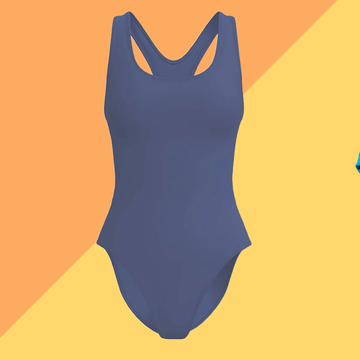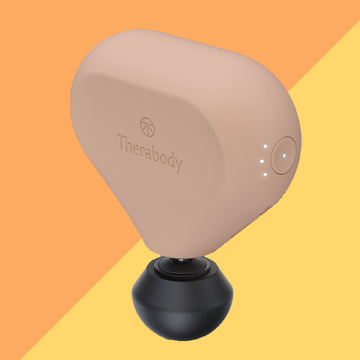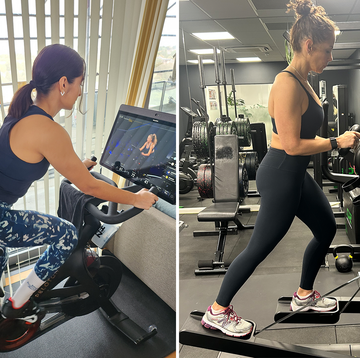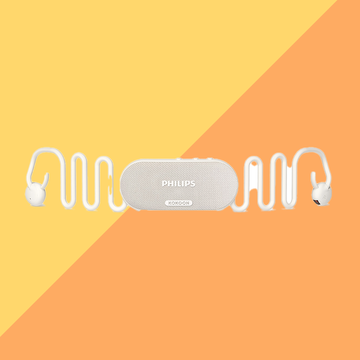We earn a commission for products purchased through some links in this article.
How to stay warm while exercising outdoors this winter
Plus all the kit you need to beat the freeze

If the cold, miserable January weather has derailed your new year exercise plans, you’re not alone. Mustering up the motivation to lace up your trainers and venture outside for a workout when it’s freezing, windy and pouring with rain is hard.
Yet, despite the overwhelming temptation to skip your session and curl up on the sofa with a hot chocolate instead, you could be missing out on some major benefits. Evidence shows that working out in nature can help boost mood, reduce stress and improve self-esteem. According to one Finnish study, it can also have a positive impact on sleep quality, while research published in Environment, Science and Technolgy notes that outdoor workouts are associated with greater feelings of satisfaction and revitalisation.
To help you reap the benefits of winter exercise – and stay safe and comfortable while doing it – we’ve asked personal trainers Caroline Idiens, founder of Caroline’s Circuits, and Nancy Best, founder of Ladies Who Crunch, to share their top tips. We’ve also rounded up the best kit to keep you comfortable while you run, jump, hike or cycle.
How to motivate yourself to exercise during winter
Work out in the morning: “Exercise in the morning before the day’s to-do list takes over,” suggests Idiens. “To make this as easy as possible, lay weatherproof kit out the night before so when the alarm goes off, it’s easy to get straight into the right frame of mind.”
Do what you enjoy: “You’ll keep showing up if you want to do it,” says Idiens. If you don’t enjoy running, then go for a brisk walk instead. There’s no point banging your head against a brick wall, and you’re more likely to stick to something you like.
Get social: “Exercising with a partner helps keep you accountable, and it’s fun to share the experience with someone,” adds Idiens. “Even if you agree to meet for a 30-minute walk, you’ll feel more energised and all the better for it. You can enjoy a warm tea or coffee afterwards.”
How do you stay warm when exercising in the cold?
Once you’ve psyched yourself up for a winter workout, it’s important you’re sufficiently prepared for the outdoor conditions. Here, Idiens shares her top tips.
Warm up and cool down: You should be warming up and cooling down before and after all your sessions, but making the time is particularly important during the colder months. “The body takes longer to warm up in winter, so investing time to warm the muscles, joints, tendons and ligaments is key. The same goes for afterwards.” she says. “Doing this will greatly reduce your risk of injury and muscle soreness and allow you to keep training consistently.”
Watch your breathing: “You may notice a burning or irritation of the throat when you inhale cold air,” notes Idiens. “You can adjust your breathing to mitigate this by inhaling through the nose and exhaling through the mouth.”
Stay hydrated: “This might sound a bit mad when you think you might not be getting as sweaty, but it’s really important to keep on top of your hydration in winter,” she explains. “You’ll be sweating and losing water through breathing in the colder air, so you need to keep taking fluids on board.”
Monitor the weather: To exercise or not to exercise? “Be mindful of how your body copes in cold weather and gauge your decision on this,” she advises. “If you’re running or walking, be aware of ice and take it slow. If you’re unsure, stay indoors, roll out a mat and enjoy an at-home fitness class.”
What to wear for a workout in winter
According to Best, having the right kit can make a world of difference for performance, enjoyment and safety. “It’s important to regulate your body temperature when the weather’s cold,” she says. “Your body works harder to keep your blood flowing to your core and vital organs, which can lead to poorer circulation around areas like your hands and feet.”
To protect your extremities, she recommends investing in a good pair of gloves and some thick socks. A beanie hat or ear warmer are also worth considering.
“It’s tempting to wear a cosy tracksuit, but I'd recommend wearing multiple layers that you can slowly remove as you need to,” she adds.
When it comes to fabric, moisture-wicking, breathable materials like polyester, nylon, bamboo and wool are best. Steer clear of cotton, which traps moisture and causes friction. If rain is on the cards, a good quality waterproof jacket should provide some insulation while keeping out the damp and cold.
The best winter workout gear 2025
Priyankaa is our sleep and wellness expert, specialising in expert-tested reviews and roundups on the latest health and fitness products. From walking boots to running machines, Priyankaa has written about hundreds of products and is passionate about providing in-depth, unbiased reviews. Plus, as an avid runner and gymgoer, she knows exactly what to look for when finding the right gymwear, fitness tracker or earphones.
Priyankaa has an MA in Magazine Journalism from Cardiff University and over five years’ experience in health and fitness journalism. Priyankaa has written for Stylist’s Strong Women Training Club, where she regularly wrote about diversity in the fitness industry, nutrition tips, training advice and her experience completing various fitness challenges. She has also written for a variety of publications including Business Insider, Glamour, Bustle, Metro, HuffPost UK, gal-dem and more. Outside of work, Priyankaa can usually be found trying out a new gym class, seeking out London's best eats or watching a Spanish TV show in a bid to keep up her language skills.


13 best electrolyte drinks to keep you hydrated

A sleep psychologist shares her wind-down routine

These cooling PJs are the dream for hot sleepers

The best period swimwear, tried and tested
















